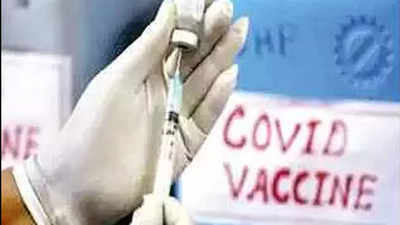- News
- City News
- mumbai News
- Maharashtra hits 8 crore vaccinations, but with urban-rural skew
Trending
This story is from September 29, 2021
Maharashtra hits 8 crore vaccinations, but with urban-rural skew
Maharashtra has completed eight crore vaccinations against Covid-19, immunizing nearly 62% of its population with at least one dose and over a quarter with both. Experts, however, called for an urgent review of the immunisation strategy to address disparity in coverage between districts.

Picture used for representational purpose only
MUMBAI: Maharashtra has completed eight crore vaccinations against Covid-19, immunizing nearly 62% of its population with at least one dose and over a quarter with both. Experts, however, called for an urgent review of the immunisation strategy to address disparity in coverage between districts.
The state administered 8,00,57,994 doses until Tuesday evening, covering 5.65crore with at least one shot and 2.35crore with both.But 23 of the 35 districts are below the state’s average of 25.6% in complete vaccination. Nanded and Hingoli at the bottom have given double doses to barely 14% of population in comparison to Mumbai’s 44% and Pune’s 39%. With travel unhindered now, it could be a threat.
Immunologist Dr Vineeta Bal from Indian Institute of Science Education and Research (IISER), Pune said in places where vaccine coverage and sero-positivity is low, chances of outbreaks are higher. “If somebody is coming from a district with low coverage and goes to another district with similar poor coverage, person will be capable of spreading the infection to a significant population because a big share is uncovered,” she said. While the third wave may not be huge, there could be localised outbreaks, say after a wedding or a political rally.
Disproportion plays out in single dose immunization too, where 19 districts are far below the state average. In Nanded, which has lowest coverage, 38% of its population has got a single shot. In comparison, 89.5% in Mumbai have got at least one jab.
In terms of age, data shows more than 30% who are 45-plus are yet to get even one shot. In the 18-44 group, it is nearly 50%. Epidemiologist Dr JP Muliyil, member of the National Technical Advisory Group on Immunisation, said states mustn’t forget the end goal of vaccination is to prevent deaths. “In younger people, there have been three deaths in a population of 10,000, which is negligible,” he said, calling it imperative to cover elderly or those with comorbidities
In Maharashtra, almost 45% of vaccine doses have been administered in Mumbai, Pune, Thane and Nagpur alone. An official justified it saying the focus was always on vaccinating thickly populated cities, where mobility is higher. But in Muliyil’s opinion, it is flawed to link vaccination to RT-PCR positive cases rather than deaths.
The strategy should also consider serological survey findings, says Bal. Mumbai’s fifth sero-survey found antibodies in 85% people, which begs the question as to whether centres with higher seroprevalence should continue to get more doses, she said.
The state administered 8,00,57,994 doses until Tuesday evening, covering 5.65crore with at least one shot and 2.35crore with both.But 23 of the 35 districts are below the state’s average of 25.6% in complete vaccination. Nanded and Hingoli at the bottom have given double doses to barely 14% of population in comparison to Mumbai’s 44% and Pune’s 39%. With travel unhindered now, it could be a threat.
Immunologist Dr Vineeta Bal from Indian Institute of Science Education and Research (IISER), Pune said in places where vaccine coverage and sero-positivity is low, chances of outbreaks are higher. “If somebody is coming from a district with low coverage and goes to another district with similar poor coverage, person will be capable of spreading the infection to a significant population because a big share is uncovered,” she said. While the third wave may not be huge, there could be localised outbreaks, say after a wedding or a political rally.
Disproportion plays out in single dose immunization too, where 19 districts are far below the state average. In Nanded, which has lowest coverage, 38% of its population has got a single shot. In comparison, 89.5% in Mumbai have got at least one jab.
Experts say the state must urgently alter its strategy of allocating the bulk of doses to bigger districts, particularly if seroprevalence is more than 80%. They say the urban bias may impact those with limited access.
In terms of age, data shows more than 30% who are 45-plus are yet to get even one shot. In the 18-44 group, it is nearly 50%. Epidemiologist Dr JP Muliyil, member of the National Technical Advisory Group on Immunisation, said states mustn’t forget the end goal of vaccination is to prevent deaths. “In younger people, there have been three deaths in a population of 10,000, which is negligible,” he said, calling it imperative to cover elderly or those with comorbidities
In Maharashtra, almost 45% of vaccine doses have been administered in Mumbai, Pune, Thane and Nagpur alone. An official justified it saying the focus was always on vaccinating thickly populated cities, where mobility is higher. But in Muliyil’s opinion, it is flawed to link vaccination to RT-PCR positive cases rather than deaths.
The strategy should also consider serological survey findings, says Bal. Mumbai’s fifth sero-survey found antibodies in 85% people, which begs the question as to whether centres with higher seroprevalence should continue to get more doses, she said.
End of Article
FOLLOW US ON SOCIAL MEDIA











